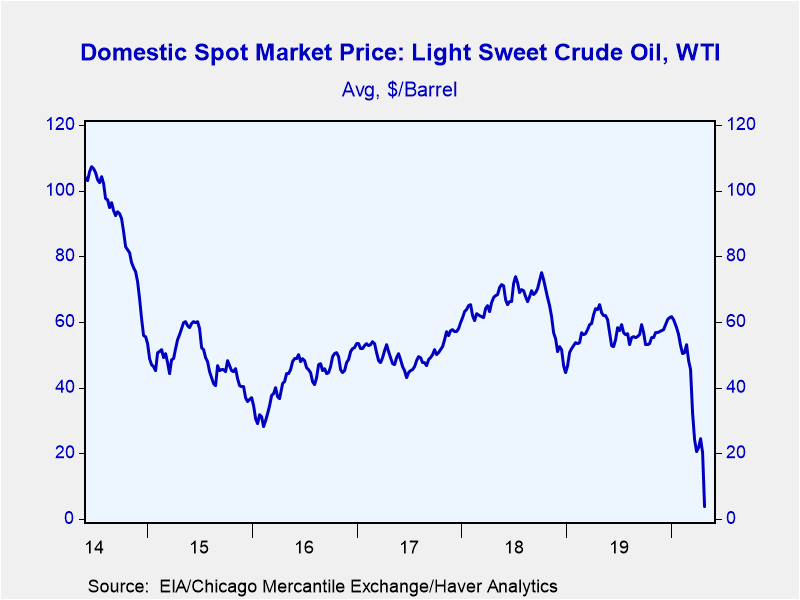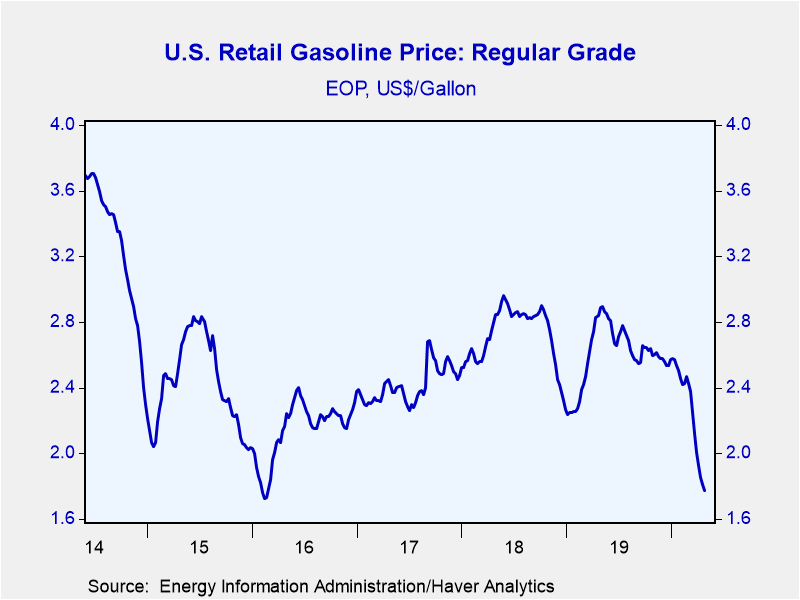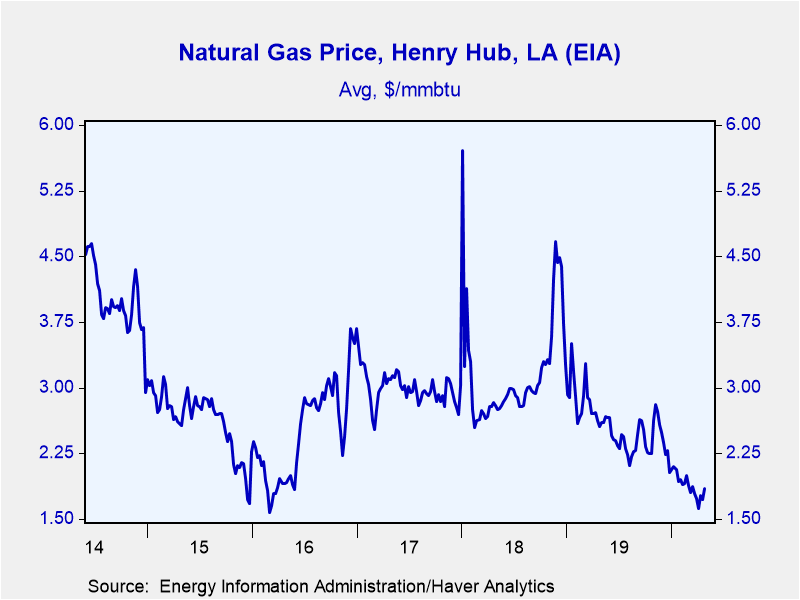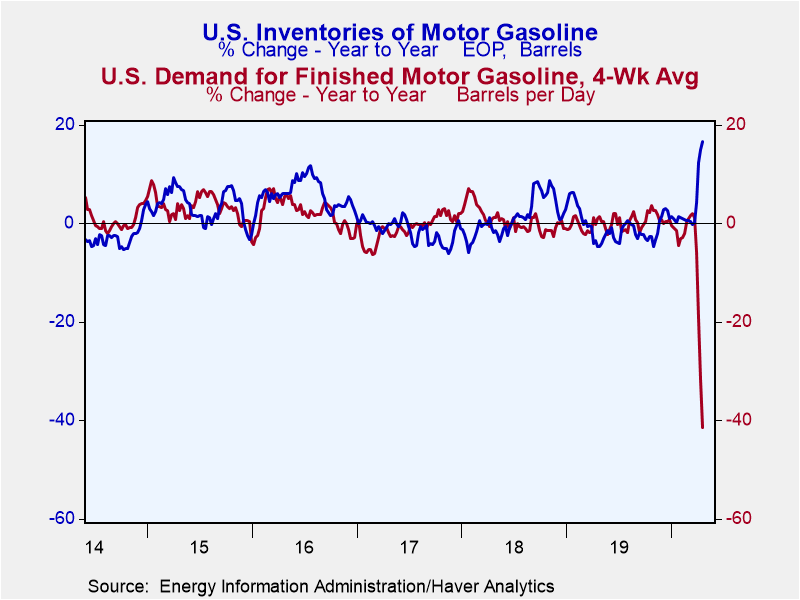 Global| Apr 28 2020
Global| Apr 28 2020U.S. Petroleum Prices Collapse While Nat Gas Rises
by:Sandy Batten
|in:Economy in Brief
Summary
• Crude oil prices collapsed last week but have rebounded recently. • Gasoline prices fall as drivers shelter at home. • Natural gas prices have been volatile. The spot price of West Texas Intermediate crude oil collapsed to $3.83 [...]
• Crude oil prices collapsed last week but have rebounded recently.
• Gasoline prices fall as drivers shelter at home.
• Natural gas prices have been volatile.
The spot price of West Texas Intermediate crude oil collapsed to $3.83 (-94.1% y/y) per barrel in the week ended April 24 from an average of $20.11 in the previous week. This was the lowest weekly average price in the history of the series which dates back to 1984. The weekly average was distorted by the daily price falling into negative territory (-$36.98 per barrel on April 20) as inadequate storage led to a selling frenzy on the last day of the current futures contract. The price has since rebounded into positive territory ($12.78 per barrel at yesterday's close). The price of Brent crude oil also declined sharply during the most recent week but did not face the April 20 sell-off that WTI experienced. The Brent price fell sharply to $21.75 per barrel, the lowest since March 2002, in the week ended April 24 from $29.18 the previous week. And it fell further to $19.98 yesterday.
Reflecting the fall in crude prices and the general lack of demand from sheltering at home, retail gasoline prices declined to $1.77 per gallon (-38.6% y/y) in the week ended April 27 from $1.81 per gallon the previous week. The most recent price is the lowest since the week ended February 15, 2016. Haver Analytics adjusts the gasoline price series for regular seasonal variation. The seasonally adjusted price fell to $1.67 per gallon, the lowest since January 2004, from $1.73.
The average price of natural gas jumped up to $1.85/mmbtu (-27.7% y/y) in the week ended April 24 from $1.72/mmbtu the previous week. This was the second increase in the past three weeks. However, natural gas prices have been extremely volatile recently. Yesterday, the price slid to $1.68/mmbtu.
Reduced oil and product prices reflect a collapse in demand and a rise in supply. In the four weeks ending April 17, gasoline demand plummeted 41.4% y/y, while total petroleum product demand fell 25.4% y/y. Crude oil input to refineries declined 17.0% y/y in the past four weeks. At the same time, gasoline inventories rose 16.6% y/y and inventories of all petroleum products increased 6.1% y/y.
These data are reported by the U.S. Department of Energy. The price data can be found in Haver's WEEKLY and DAILY databases. Greater detail on prices, as well as the demand, production and inventory data, along with regional breakdowns, are in OILWKLY.
| Weekly Energy Prices | 04/27/20 | 04/20/20 | 04/13/20 | Y/Y % | 2019 | 2018 | 2017 |
|---|---|---|---|---|---|---|---|
| Retail Gasoline ($ per Gallon Regular, Monday Price, End of Period) | 1.81 | 1.85 | 1.92 | -36.2 | 2.57 | 2.27 | 2.47 |
| Light Sweet Crude Oil, WTI ($ per bbl, Previous Week's Average) | 20.10 | 24.40 | 21.72 | -68.5 | 56.91 | 64.95 | 50.87 |
| Natural Gas ($/mmbtu, LA, Previous Week's Average) | 1.72 | 1.77 | 1.62 | -34.5 | 2.57 | 3.18 | 2.99 |
Sandy Batten
AuthorMore in Author Profile »Sandy Batten has more than 30 years of experience analyzing industrial economies and financial markets and a wide range of experience across the financial services sector, government, and academia. Before joining Haver Analytics, Sandy was a Vice President and Senior Economist at Citibank; Senior Credit Market Analyst at CDC Investment Management, Managing Director at Bear Stearns, and Executive Director at JPMorgan. In 2008, Sandy was named the most accurate US forecaster by the National Association for Business Economics. He is a member of the New York Forecasters Club, NABE, and the American Economic Association. Prior to his time in the financial services sector, Sandy was a Research Officer at the Federal Reserve Bank of St. Louis, Senior Staff Economist on the President’s Council of Economic Advisors, Deputy Assistant Secretary for Economic Policy at the US Treasury, and Economist at the International Monetary Fund. Sandy has taught economics at St. Louis University, Denison University, and Muskingun College. He has published numerous peer-reviewed articles in a wide range of academic publications. He has a B.A. in economics from the University of Richmond and a M.A. and Ph.D. in economics from The Ohio State University.










